The links between burning fossil fuels and greenhouse gas emissions, particularly in terms of climate change, were considered earlier than you may think.
It was a Swedish scientist named Svante Arrhenius who was the first to state that the use of fossil fuels could contribute to global warming, way back in 1896.
The issue has become a hot-button topic over the course of the last few decades. Today, there is a general shift towards environmental awareness and the sources of our energy are coming under closer scrutiny.
This has led to the rise of a number of alternatives to fossil fuels. While the viability of each can be argued, they all contribute something positive when compared to fossil fuels.
Lower emissions, lower fuel prices, and the reduction of pollution are all advantages that the use of alternative fuels can often provide.
Here we examine 11 of the most prominent alternative fuel sources and look at the benefits they offer and the potential for increased uptake in the coming years.
11 Alternatives to Fossil Fuels That Are Currently Available
- Hydrogen Gas
- Tidal Energy
- Biomass Energy
- Wind Energy
- Geothermal Power
- Natural Gas
- Biofuels
- Wave Energy
- Hydroelectric Energy
- Nuclear Power
- Solar Power
What is a Renewable Energy Source?

A renewable energy source is anything that can be replenished after it has been used for energy. This can be different from alternative energy sources.
For example, natural gas is an alternative to coal, but it doesn’t renew itself once it has burned.
On the other hand, solar energy is renewable because solar radiation comes to earth every day without fail. All we have to do is harness it and convert it to electricity.
Organic materials, especially annual crop waste, can be a cost-effective source of biomass to help meet our energy needs.
Burning these materials creates greenhouse gases so they aren’t a source of completely clean power, but they create less environmental damage and help reduce dependence on crude oil.
2 of the Best Renewable Energy Sources
The sun is the world’s largest renewable energy source. Water is our second best source of renewable power.
The water cycle tends to ensure that water sources renew, though inland droughts can diminish our green energy output at hydroelectric dams.
Combining alternative energy technologies such as solar panels and hydroelectric dams can help to offset the energy lost by diminishing water flows.
To achieve long-term success with energy independence we should focus on incorporating alternative sources of energy into our national energy portfolio.
What Are the Best Types of Alternative Energy?
The best alternatives to fossil fuels are those that are also renewable. Solar power, wind power, hydroelectric power, tidal, and wave energy are all renewable and clean sources of energy.
Biomass and biofuels can be good sources of alternative energy, but only if they’re produced responsibly. Renewable energy purchasers should be aware of the source of biomass, for example.
So what are some alternatives to fossil fuels?
1. Hydrogen Gas
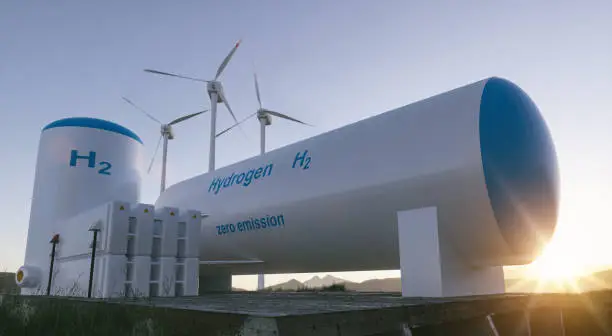
One alternative to fossil fuels is hydrogen gas. Hydrogen is a completely clean burning fuel. Once produced, hydrogen gas cells emit only water vapor and warm air when in use.
This has always been a tantalizing source of clean-burning fuel. The main inhibiting factor is the cost to produce hydrogen fuel cells.
Sources of Hydrogen Gas
Hydrogen is a component of many molecules and when it can be split away and harvested efficiently it is a clean-burning fuel. Here are some sources of hydrogen gas.
- Water
- Biomass
- Natural gas
There are quite a few technological advances being made to help capture clean-burning fuel from waste streams like biomass. We’ll cover those later in the article. However, hydrogen gas is one potential fuel.
How is Hydrogen Gas Made from Natural Gas?
Most of the US supply of hydrogen gas is harvested from natural gas pipelines. Methane from natural gas is captured and exposed to high-pressure steam.
This process called methane reforming causes the methane molecule to split into one carbon monoxide and 3 hydrogen gas molecules which are then filtered out to produce pure hydrogen gas.
How is Hydrogen Gas Made From Water?
The process of electrolysis is used to split water molecules into hydrogen and oxygen. Electricity is passed through the electrolyzer which has an anode and a cathode.
When water is passed into the anode, the water molecule splits into one oxygen and 2 hydrogen atoms which are captured as hydrogen gas.
How to Make Hydrogen a Clean Energy Source
While hydrogen capture is often based on a fossil fuel energy source to create the steam for methane reforming, future developments are sure to pair electrolyzers with solar cells to create clean energy alternatives.
2. Tidal Energy
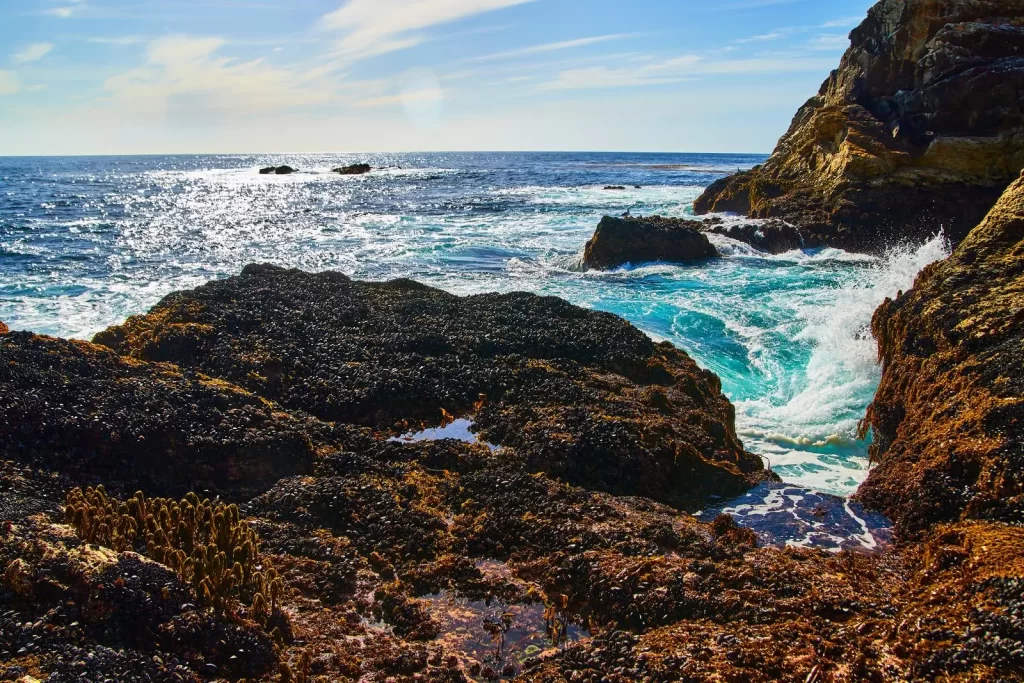
While tidal energy uses the power of water to generate energy, much like hydroelectric methods, its application actually has more in common with the pros of wind power in many cases.
Tidewaters and waves contain 2 kinds of energy.
- Kinetic energy – The speed at which the wave or tide flows
- Potential energy – The volume of water that is displaced during the natural ebb and flow pattern
Though tide energy is a fairly new technology, its potential is enormous. A report produced in the United Kingdom estimated that tidal energy could meet as much as 20% of the UK’s current electricity demands.
3 Ways to Capture Tidal Energy
There are advantages and disadvantages of tidal energy. The main advantage is its clean energy, but the disadvantage is that it disrupts marine life.
While new technologies frequently roll out for testing to capture the enormous energy potential in tidal fluctuations, 3 main ways to capture tidal energy are currently being used.
- Tidal stream generators
- Tidal lagoons
- Tidal barrages
Each of these is based on capturing the stored potential energy in the volume of water that moves with the tides and turning it into kinetic energy that can generate electricity.
Tidal energy is one of the most dependable sources of energy on the planet, though its capture is not without ecological consequences as we’ll discuss in this section.
How Tidal Stream Generators Produce Energy
The most common form of tidal energy generation is the use of Tidal Stream Generators.
These are similar to wind turbines but they are placed in the tidal stream areas where the water moves the turbine. The turbine produces electricity that is gathered into a grid substation for distribution.
There are 2 main barriers to tidal stream generator implementation.
- Cost – the cost to build, install, maintain, and distribute the power from a large off-shore installation can be prohibitive.
- Location limitations – Not all off-shore areas have tidal streams that are strong enough to support an installation. Further, not all areas that have good tidal streams are open for development.
Tidal stream generation is typically not seen as a complete answer to power generation needs.
Rather it is a good supplement to existing power grid supplies for areas that are prime for tidal stream power generation.
Environmental Impact of Tidal Stream Generators
The negative is that these turbines are disruptive to the tidal stream they seek to capture which can decrease the efficiency of the array.
This tidal stream disruption can have a large negative impact on marine life including fish and mammals that rely on the natural tidal stream flow for feeding and migration.
These turbines also change the underwater biome in their immediate vicinity. Studies have been done to measure the ecological impact, especially on marine mammals, that could result from these turbines.
How Tidal Lagoons Produce Energy

Tidal lagoons are a slightly more passive way to capture the potential energy in rising and falling sea tides.
A manmade lagoon captures seawater during the rising tide. Turbines in the lagoon wall are powered as the tide comes in and also as it goes out.
Water can also be captured inside the lagoon and released to control the power generation much like the giant Swiss water battery.
The energy potential is stored in the mass of water then as the water is released through the turbines the energy is extracted and converted into electricity.
Environmental Impact of Tidal Lagoons
Tidal lagoons have a large environmental impact where they are constructed because they disrupt the natural shoreline and its corresponding habitats and biomes.
They also change sedimentation onshore and offshore which affects fish, shellfish, and other marine life that depends on sedimentation patterns for feeding, migration, and nesting.
However, over time the environment adjusts to account for the new barriers, and marine life shifts accordingly. The overall impact of a tidal lagoon is small compared to off-shore drilling and other activities.
How Tidal Barrages Generate Electricity

A tidal barrage is an innovative way to capture potential energy from tidal waters in the same way that a hydroelectric dam collects energy from a flowing river.
It is similar to a tidal lagoon except that it dams an entire estuary for the purpose of power generation. All tidal water from rising and falling tides can be used to move turbines in the wall of the barrage.
The most famous tidal barrage is located on the Rance river in France where it flows into the English Channel.
This barrage captures the rising tide and combines it with energy from the flowing river to create a maximum power output of 240 megawatts.
While 240 megawatts is only about .12% of France’s power usage it is a powerful tool for generating clean energy.
This barrage is using reliable tidewaters and flowing river water to create renewable clean energy.
Environmental Impact of Tidal Barrages
Tidal barrages have a greater overall environmental impact than tidal stream generators and tidal lagoons because they enclose an entire estuary.
This changes the natural tide patterns which affect marine life of all kinds that rely on the tides for food, migration, and nesting.
Tidal barrages greatly change the sedimentation patterns in the estuary which changes the biome and results in a shift in the marine life present in the area.
While marine life will adjust to some extent, the biome will never recover and certain changes to the flora and fauna of the area will not recover.
The final negative impact is on shore birds that require an estuary for nesting, breeding, and feeding. The estuary becomes basically a tidal lake which completely changes the food sources and habitat.
Here’s a quick video that illustrates 2 tidal renewable energy sources.
Read More: What is the Definition of Flora and Fauna? Here’s why flora and fauna are important and what they are.
3. Biomass Energy

Biomass energy comes in a number of forms and is one of the more quickly advancing industries in the energy alternatives sector.
There are a number of biomass sources that are being used to create energy. Biomass is any plant or animal product that can be burned directly or converted into a type of fuel for burning.
- Wood – firewood, wood scraps, pellets, sawdust, scrap lumber
- Black liquor – waste fluid from chemically pulping wood that can be concentrated by evaporation and then burned as fuel
- Crop waste and food waste – some can be burned directly while others are converted into biofuels
- Municipal trash and yard waste – everything from clothing and paper to yard waste can be burned to generate energy. Other types of trash can be covered with special collectors that gather methane for refining into hydrogen gas.
- Human and animal solid waste – manure and solid waste are broken down by anaerobic bacteria and methane is produced which is converted to hydrogen gas.
Not all biomass sources are equal. There are biomass energy advantages and disadvantages to be aware of. We’ll discuss several important factors about biomass energy generation that you need to know.
How Wood Creates Electricity
Burning wood has been used for thousands of years to create heat, but it can also be used to generate steam that powers turbines to create electricity or refine methane gas.
Burning wood has more recently been frowned upon because it creates air pollution particulates, but the environmental impact of wood burning is significantly less than burning fossil fuels.
In terms of electricity generation, wood is an increasingly common source of biomass energy harvesting.
Some biomass is wood scraps from paper mills, furniture manufacturers, and other wood industries with scraps. Many of these factories burn their own scraps to power the plant – lowering their carbon footprint.
Environmental Impact of Wood Biomass Harvesting
Many fossil fuel energy plants are being decommissioned in favor of biomass plants in a move that is creating a $50 billion annual industry in the US, but at what cost?
Much of the “biomass” that is being burned in these new power generation plants are trees that are cut and chipped to make biomass for burning in these new plants. The result is widespread deforestation.
The environmental impact is huge and obvious – loss of bird, mammal, and plant habitats. While trees are a renewable energy resource, the harvest and replanting cycle takes decades.
How Waste is Turned Into Electricity
Household and municipal waste, old clothing, crop waste, and human and animal solid waste can all be turned into electricity.
- Agricultural waste like cereal and grain stalks, sugarcane stalks, cornstalks, rice straw and hulls, and other types of woody waste can be directly burned as biomass to generate electricity.
This type of power generation is simple. The fuel is burned to heat water. The water turns into high-pressure steam which rises to move turbines which convert the steam energy into electricity.
- Waste that undergoes anaerobic digestion such as human waste, animal manure, and decomposing garbage produces methane gas that can be captured and converted into fuel.
When methane gas is produced in significant quantities it can be converted into hydrogen gas using methane reforming. Hydrogen gas is a clean-burning fuel.
- Food industry waste can be turned into biofuels. We’ll talk about this later in our section on biofuels.
For now, understand that food products can have a third life as biofuels which have a very positive environmental impact.
Environmental Impact of Turning Waste Into Energy

The environmental impact of not turning waste into energy is much greater than any impact there may be from harvesting and conversion of waste into energy.
Waste to energy conversion has the following positive environmental impacts.
- Waste is broken down faster than if it just sits naturally decomposing
- Waste that is not harvested for energy produces more greenhouse gas emissions than waste that is used to harvest energy
- Even small biofuel operations can help by providing alternatives to fossil fuels
The fact is that every human and every animal produces waste. We can limit our waste production in the first place, but we can also harvest the potential energy in our waste.
This energy harvest reduces waste’s environmental impact while also decreasing our dependence on fossil fuels.
A negative environmental impact that comes from burning waste is that particulate and chemicals found in the garbage are released into the atmosphere.
Plants that employ this method need to use industrial scrubbers to clean the air passing through the smokestacks before it is released into the atmosphere.
4. Wind Energy
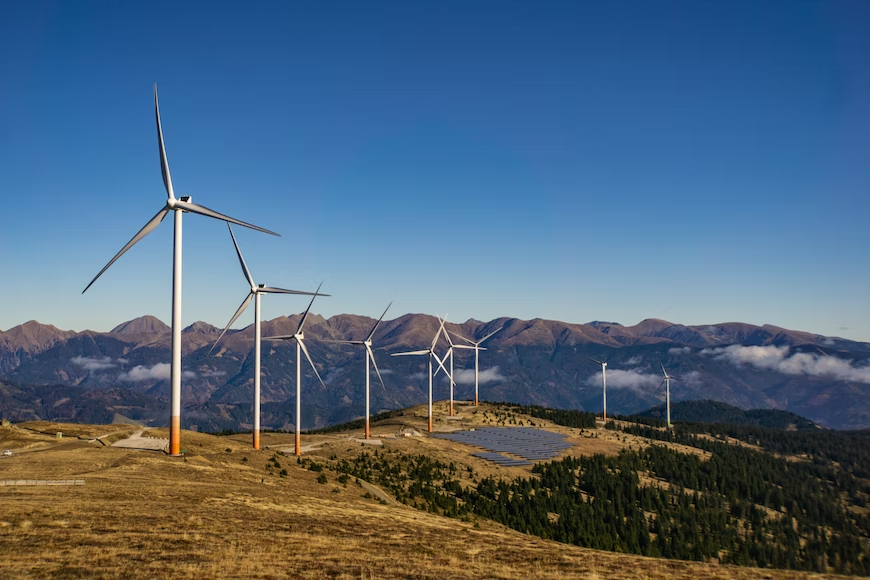
Wind energy is one of the most viable alternatives to fossil fuels. It has become increasingly popular in recent years with wind farms being erected across wide swaths of open land in the United States.
Wind energy has created a new $10 billion annual industry in the US.
Money is spent on the mining of metals, materials manufacture, turbine manufacture and replacement, turbine maintenance, and distribution network.
A significant part of this money is spent on land purchases and land leases for turbine placement.
How Do Wind Turbines Generate Electricity?
A wind turbine is the grown-up version of the windmill. The wind turbine is a relatively simple machine though the size is astounding.
When strong enough winds hit the propellers they spin around a single axis. This spinning motion turns a generator inside the turbine head.
The generator produces electricity created by wind energy which is collected at and distributed from a regional power substation.
Here’s what you need to know about wind turbines.
- A single wind turbine produces a maximum of 2.75 megawatts of electricity.
- A turbine produces less than 50% of its output potential because of wind variability.
- Each turbine can power about 940 homes based on average electrical use.
- The lifespan of a turbine is 20-25 years.
- The cost of a turbine is between $2 and 4 million dollars to make and install.
- The annual cost to maintain a turbine is around $45,000 per year and increases as the turbine ages.
- Some parts of a turbine are recyclable – mainly the copper wiring and other internal components.
- The fiberglass blades and other housing components end up in the landfill.
- A turbine pays for itself after about 14 years in the field. That means it has about 10 years of net positive energy production before decommissioning.
Wind energy is anything but free. The costs to produce wind power are sometimes subsidized and they are passed on to consumers through energy taxes, purchased wind energy credits, and power bills.
For areas that can justify the cost of wind turbine installation and upkeep due to reliable prevailing winds, it can be a winning solution to help relieve fossil fuel consumption or boost energy production.
Environmental Impact of Wind Turbines
It’s important to understand that giant wind turbine installations have a significant impact on the location where they’re installed.
- When installed in food production areas the amount of food produced usually decreases though farmers usually try to work around the turbine bases to keep up crop production.
- Many turbine installations are placed in areas where they have a minimal environmental impact. However, they still impact bird migration patterns, disrupt breeding and nesting sites, and change the biome.
- Birds and bats frequently fly into turbine blades or are hit by them and die.
In general, the environmental impact of a wind turbine is much less than burning its equivalent in fossil fuels, but it isn’t without its drawbacks for the natural world.
Read More: FUN Facts About Wind Energy. Here are some more unique facts you may not know!
5. Geothermal Power
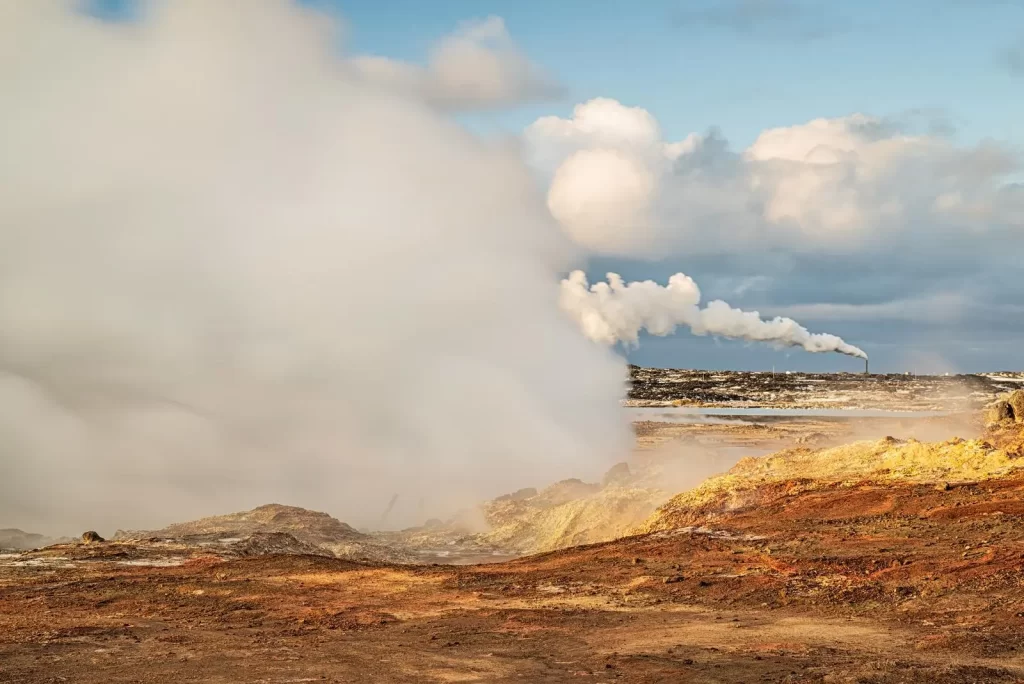
Geothermal power has been harnessed since the dawn of humanity. Anywhere that the earth’s hot water rises to the surface as a geyser, hot spring, volcano, or fumarole has a potential for harvesting energy.
How Does Geothermal Energy Turn Into Electricity?
Geothermal energy pros and cons are hotly debated in academic circles.
However, geothermal energy can be safely turned into electricity the same as any other fuel, but it’s clean and renewable.
The hot water source is tapped in different ways depending on how hot it is. It’s steam that is needed to produce electricity from geothermal energy.
One of the advantages of geothermal energy is that the energy is self-sustaining once the plant is installed and operational.
If a source of dry steam is located or the water is hot enough to produce a consistent flow of highly pressurized steam, then the geothermal energy flows on its own.
The steam travels upward toward turbines. As the steam turns the turbines they run electric generators which pass along the electricity to power substations.
The used water is then pumped back into the earth for reheating creating a renewable resource based on the earth’s own energetic activity.
Environmental Impact of Geothermal Energy Production
Geothermal energy is an incredibly clean source of electricity. It’s also an old source of energy with the first commercial plant coming online in 1913.
The energy produced by geothermal power plants is 97% clean and requires no fossil fuels to produce.
The hot water that comes out of the earth usually contains hydrogen sulfide. Power plants use emissions scrubbers to keep this out of the environment.
There is naturally some habitat loss around a geothermal plant area, but there isn’t a significant impact to flora and fauna in the area because these plants are a closed-loop system.
This means that the water is extracted through a small borehole in a rock fissure or similar area, pumped or naturally pressurized into a closed turbine generator, then released back into the ground.
They have a very positive effect on the overall environment by producing clean, reliable renewable energy source that is not dependent on any type of fossil fuel.
In areas where natural geothermal energy occurs, it is a great alternative to fossil fuels that creates a minimum disruption in the earth’s crust.
This video discusses the various ways that geothermal energy is used as an alternative to fossil fuels – including electricity generation.
6. Natural Gas
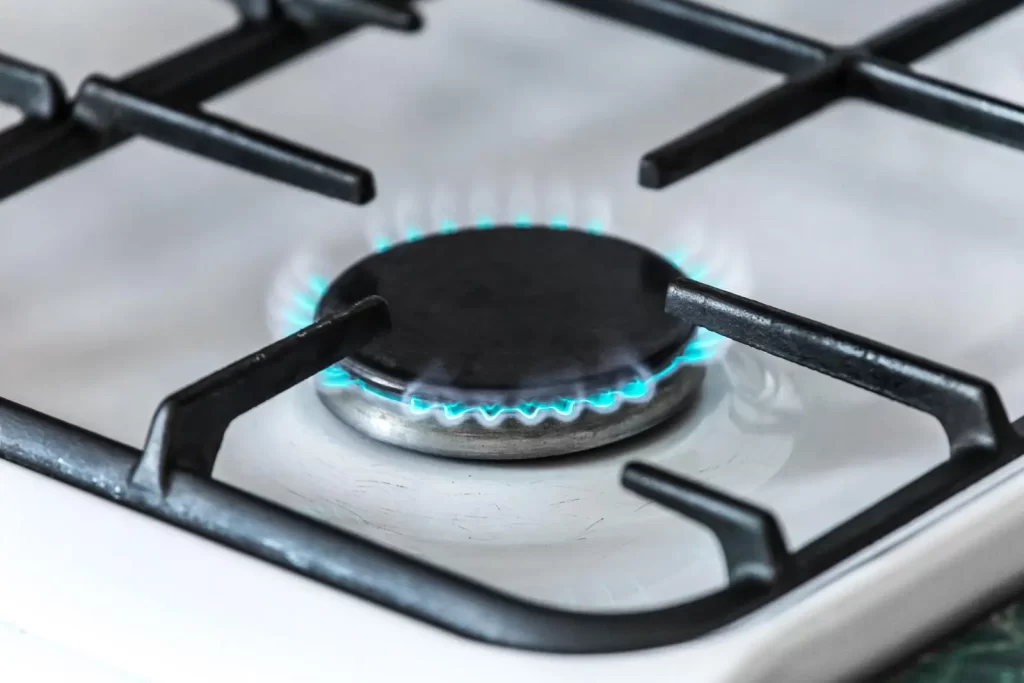
Natural gas is an example of natural resources that have been used for a number of decades. However, the progression of compression techniques has made it a more viable alternative energy source.
In particular, it is being used in cars to reduce carbon emissions. It isn’t a totally clean solution but it does produce 15 to 20% fewer carbon emissions than regular gasoline when used in a car.
Where Does Natural Gas Come From?
Natural gas is not one of the alternatives to fossil fuels because it is a type of fossil fuel. However, it is abundant and the impact of burning natural gas is much less than coal and oil.
It is produced by the decomposition of ancient animals and plants and occurs in pockets where coal and crude oil are also found.
Natural gas is a natural byproduct of oil refining, though it’s usually burned off or “flared” to decrease the environmental impact of releasing it into the air.
How is Natural Gas Turned Into Electricity?
Natural gas is burned just like fossil fuel. The main component of natural gas is flammable methane. It’s burned to heat water which turns into steam.
The steam rises in high-pressure tubes and turns power generation turbines which generate electricity.
Environmental Impact of Burning Natural Gas
Natural gas has about 50% fewer emissions than coal and about 20% less than gasoline but it burns very efficiently. This makes it a good option for reducing emissions while maintaining energy output.
Natural gas has to be “mined” from pockets and piped to its destination. This creates an environmental impact on the flora and fauna in all areas where the pipe runs.
However, this impact is minimal along the pipeline. For the most part, it has zero impact on the area where the pipeline runs, though the extraction point and generation point have a large impact on the area.
The main impact comes from the emission of methane into the atmosphere at the point of extraction and at the point of power generation.
So while natural gas is not one of our alternatives to fossil fuels, it is a ready fuel that helps limit some greenhouse gas emissions.
7. Biofuels

Biofuels are liquid fuels that are generated by the breakdown of biomass. The most commonly used forms of biofuels are ethanol and biodiesel.
Biofuels are renewable alternative energy sources because they use animal, plant, and food waste streams that are constantly renewing.
How is Ethanol Produced?
Ethanol is a type of denatured alcohol that is produced by fermenting starchy grains and cereals like sorghum, corn, sugar cane, barley, and sugar beets.
Technically it is pure alcohol that could be consumed before it’s treated for sale as fuel. The resulting alcohol is mixed with a little gasoline to dilute it to about 95% purity and make it undrinkable.
It can’t be used in its pure ethanol form as gas alternatives for cars because it doesn’t burn quickly enough to support the internal combustion engine. It is usually mixed into regular gasoline as a 10% additive.
How is Biodiesel Produced?
Waste oils are collected including used cooking oils, animal fats, and other oils, and mixed with methanol and sodium hydroxide to be refined into burning diesel oil.
The process isn’t as simple as clarifying oil and then burning it in an engine. It takes a significant amount of refining to make it safe to put into a diesel tank without ruining the engine.
Environmental Impact of Burning Biofuels
Biofuels are a fantastic way to reuse food waste and livestock waste in the United States. However, it isn’t without its drawbacks.
- Most biofuel refineries operate on fossil fuels. This decreases the emissions benefits from the tailpipe when increased emissions offset it during production.
- The waste from biofuel refining can contaminate air and water due to pesticides and fertilizer release (especially from crops grown for ethanol production).
- Food costs are forced upward as crops previously grown for consumption are redirected toward fuel.
- Crop changes can increase land, water, and air pollution as crops intended for fuel are grown and treated differently than those grown for food.
The impacts of creating and using biofuels are still much less than fossil fuels, but they aren’t without environmental impact.
8. Wave Energy
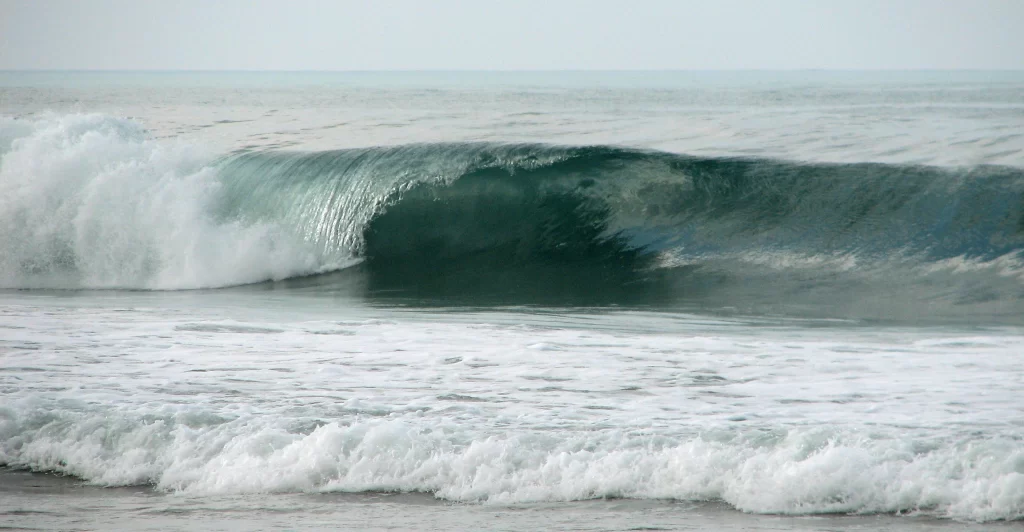
Water again proves itself to be a valuable contributor to alternative energy fuel sources with wave energy converters.
These hold an advantage over tidal energy sources because they can be placed in the ocean in various situations and locations where there is significant water displacement.
Much like with tidal energy, the benefits come from the lack of waste produced. It is also more reliable than many other forms of alternative energy and has enormous potential when used properly.
How Are Waves Used to Generate Electricity?
There is a massive amount of potential energy in the swell and ebb of natural wave patterns, especially in areas like the Pacific where waves are large and powerful.
Wave energy converters take many different forms with several features in common.
- Wave energy converters are anchored to the sea floor.
- They have some sort of floating balloon, membrane, or fin that rides the surface of the swells.
- The pressure difference in the swelling and dipping of the wave actuates a hydraulic pump that spins a turbine to generate electricity.
- These can be small bouy-type floats or large floating platforms.
Again, the cost of such systems is a major contributing factor to slow adoption.
The cost to manufacture isn’t guaranteed to pay off in the short term and cables to transmit the electricity can be tricky and expensive to install.
Further, these are only viable alternatives to fossil fuels in coastal areas that have high enough wave energy to exploit the ebb and flow as alternative energy sources.
Environmental Impact of Using Wave Energy for Electricity
Oregon State University is currently studying the impact of wave energy converters on the environment and marine life.
There is some potential that marine mammals could be entangled in mooring lines and the migration patterns of mammals and fish could be disrupted by wave energy converter installations.
9. Hydroelectric Energy
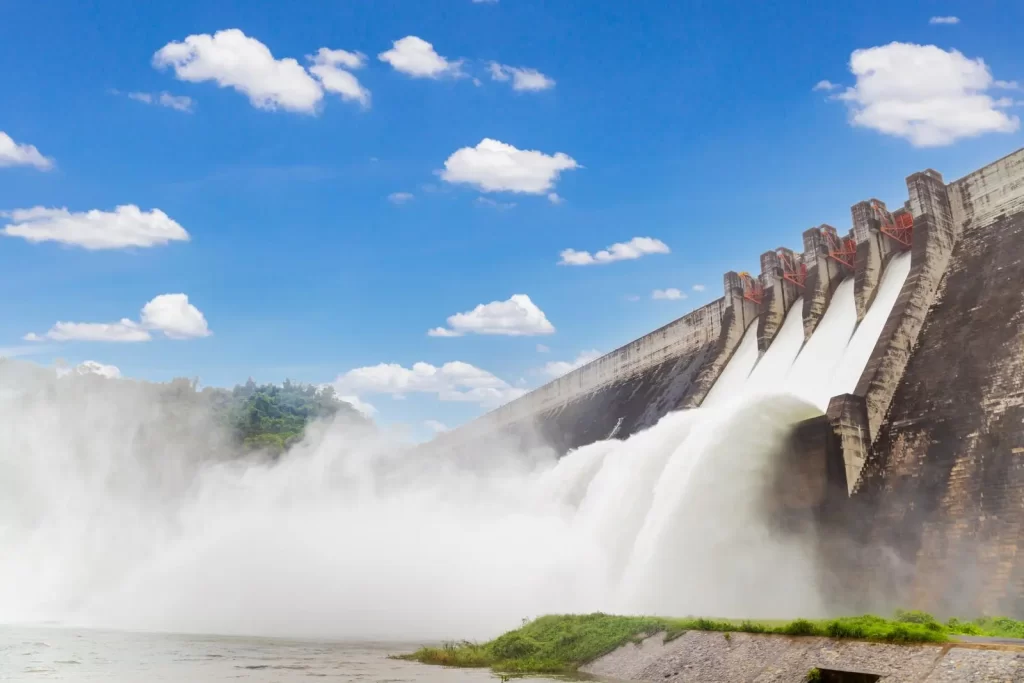
Hydroelectric methods actually are some of the earliest means of creating alternative energy, though their use began to decline with the rise of fossil fuels.
Despite this, they still account for approximately 17% of the energy produced in the United States.
Hydroelectric energy carries with it a number of benefits.
Not only is it a clean source of alternative energy, which means it doesn’t create greenhouse gases, but flowing water is one of our best renewable energy sources.
Better yet, it also offers a number of secondary benefits. The dams used in generating hydroelectric power also contribute to flood control and irrigation techniques.
What is Hydroelectric Power?
Hydroelectric power is generated by placing a dam across a river with a reliable water flow. Water backs up behind the dam forming a manmade lake or reservoir.
As water is released through the dam it passes through power generation turbines that turn the water’s energy into electricity.
There is a second type of hydroelectric power generator that is less disruptive to the natural flow of the water. Some of the water is channeled away from the main river to flow through canals.
These canals have turbines that the water passes through before rejoining the main river again.
Benefits of Hydroelectric Power
The best thing about hydroelectric power is that it’s generated without a need for fossil fuels. It uses flowing water and gravity to turn the potential energy in flowing water into clean electricity.
About 71% of all the renewable energy in the world is generated by hydroelectric power dams. The largest hydroelectric power plant in the world is China’s Three Gorges Dam.
Environmental Impact of Hydroelectric Power
The environmental impact of a hydroelectric power installation is a permanent change in the environment and ecosystem with diminishing effects as time goes on.
When a valley is flooded to make a reservoir there is a huge impact in terms of human, animal, bird, insect, and flora displacement. This habitat will not be recovered.
Fish are impacted by the newly constructed barrier. Spawning patterns are disrupted. Fish will learn to use fish ladders to get upstream but spawning rates can be affected.
On the flip side, hydroelectric power generation doesn’t usually pollute the water or air. Sedimentation patterns will change downstream, but the water usually remains clean.
Hydroelectric power remains a staple of clean alternative energy production in areas where there is enough water flow to harness for this purpose.
10. Nuclear Power

Nuclear power is amongst the most abundant forms of super clean alternative energy. About 50% of our clean energy is generated by nuclear power plants.
It is not necessarily one of our renewable energy sources because it is based on uranium mining, but the amount of energy we get from a little uranium is astounding.
There are many nuclear power advantages making it one of our best alternatives to fossil fuels.
It creates a number of direct benefits in terms of reliability, emissions, and efficiency, while also boosting the economy by creating jobs in plant creation and operation.
The drawback is that when something goes wrong with a nuclear power plant the potential for catastrophe exists. Chornobyl and Fukushima give most people a cause to doubt the safety of nuclear power.
How Does Nuclear Energy Become Electricity?
Uranium is mined and turned into little radioactive fuel pellets that are placed inside fuel rods. These are placed inside a nuclear reactor along with control rods that control the rate of nuclear fission.
As the controlled reaction progresses atoms split off of the uranium and generate heat. This is going to sound very familiar at this point.
The heat created by the nuclear reaction heats water which generates steam. The steam rises and spins power generation turbines which turn the steam’s energy into electricity.
How Safe is Nuclear Energy?
Nuclear energy pros and cons include safety issues on both sides of the argument.
In a head-to-head competition for safety, nuclear plants win over all other type of power generation plants.
There are more hydroelectric dam bursts and fossil fuel explosions than there are nuclear meltdowns. However, when a nuclear power plant has a meltdown the catastrophe is unparalleled.
As far as environmental safety is concerned, nuclear power plants produce zero greenhouse gases. They’re cleaner even than solar power but the energy produced is consistent and reliable.
When it comes to the best renewable energy source for the future, nuclear fusion is likely where our future lies. It’s completely clean, immensely powerful, and requires very little fuel.
Environmental Impact of Nuclear Energy
Despite the fact that nuclear power plants produce zero greenhouse gas emissions, there is some environmental impact from the nuclear energy process.
Uranium mines produce radioactive contaminants at the mining sites.
While these contaminated tailings are sealed so they can’t leave the site, they still contaminate more soil in the area than if they were undisturbed.
Also, spent fuel rods must be decommissioned and disposed of safely while the radioactive activity burns itself out. These are sealed in casks and then stored above ground or buried.
11. Solar Power
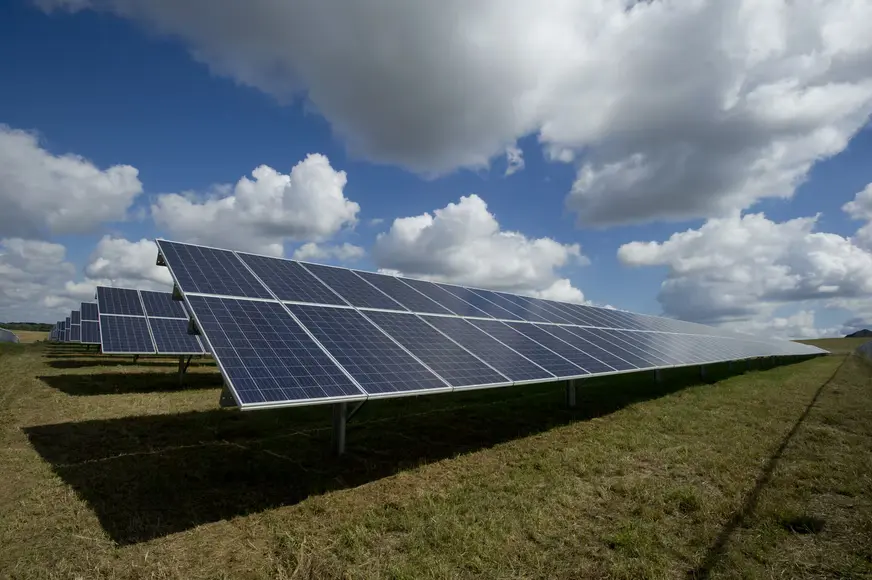
When most people think of alternative energy sources they tend to use solar power as an example. Solar energy is becoming more common and affordable with each passing year.
This is one of our favorite sources of alternative energy because solar energy arrays can be large enough for commercial use or small enough to power walkway lights at home.
Did you know that you can replace much of your daytime indoor lighting with solar tube lighting? These reflective tubes direct natural sunlight into your home to create ambient lighting that is 100% renewable!
The pros and cons of solar tubes are debatable. The fact is that after the initial installation they’re worry-free for at least 20 years. That’s a smart way to use solar power!
The technology has evolved massively over the years and is now used for large-scale energy production and power generation for single homes.
A number of countries have introduced initiatives to promote the growth of solar power. The United Kingdom’s ‘Feed-in Tariff’ is one example, as is the United States ‘Solar Investment Tax Credit’.
How Does Solar Energy Work?
Most solar energy is captured using photovoltaic (PV) panels.
These black panels are made of silicon semiconductors that react to the electromagnetic radiation emitted by the sun and turn it into an electrical current.
This electrical current can be tied back into the electrical service grid for immediate use or stored in batteries to use later.
Some commercial solar energy plans are used to help buffer times of high energy usage by pulling from battery storage to offset high consumption and help even energy costs.
Environmental Impact of Solar Energy
While solar power is touted as the best form of clean renewable energy it does have a dark side.
- For those installing solar panels on a garage or house roof, the environmental impact is minimized. However, large-scale commercial installations impact flora, fauna, and bird habitats in the area.
- For the most part, solar installations are located in areas where there is no previous agricultural use for the land, but in areas where this is an exception, there is a decrease in food production.
- Silica mining causes environmental disruption and hazards at the mining sites. This is unavoidable, but it is an environmental impact. Silica is not a renewable source material.
- The lifespan of a typical solar panel is about 25 years. When decommissioned they can’t go to a landfill because they contain hazardous materials like lead and cadmium. Some areas have recycling facilities.
Overall the environmental impact of solar power generation is nothing compared to burning fossil fuels.
The environmental impacts present will be better mitigated in the future as the world wrestles with an upcoming wave of old solar panels that must be recycled or discarded.
FAQs
Q: What is the Best Source of Alternative Energy?
A: The best source of alternative energy is solar power. It is relatively consistent, available everywhere, and harnessing solar energy is quite affordable for the average homeowner and commercial installations alike.
Q: Why Use Alternative Sources of Energy?
A: Fossil fuels are not renewable. Once we have used them all, they’re gone. Our current infrastructure makes fossil fuels affordable, but as the supply is depleted the cost rises.
The more we diversify our energy sources the more our supply will stabilize to meet demand in ways that do not require fossil fuels.
Renewable resources are our best bet for the future, though we are still limited by considerations such as the silica mining that is required to make solar panels.
Q: What is an Alternative Energy Source?
A: An alternative energy source is specifically referencing alternatives to fossil fuels, specifically coal and oil. Wind power, solar, nuclear, hydroelectric, biomass, and wave energy are among the most promising alternative energy sources.
Natural gas is considered to be an alternative energy source because it burns much more cleanly than coal and oil, but it is a non-renewable fossil fuel.
Final Thoughts
As the issues that result from the use of traditional fossil fuels become more prominent, alternative energy sources like the ones mentioned here are likely to gain further importance.
The advancement of some of these technologies has been slowed down due to the amount of investment needed to make them viable.
Many of these technologies are being combined to create a viable plan to increase our global alternatives to fossil fuels.
Join the discussion! What are your favorite renewable energy sources? Do you have thoughts on alternative energy that we didn’t mention in our article? Let us know in the comments below.
